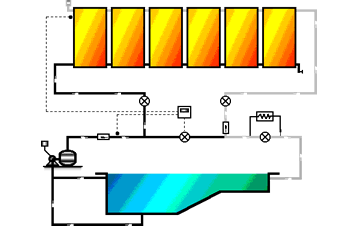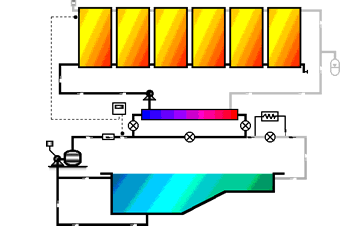
Solar Pool Heating
Warm your pool with the sun
Thermo Dynamics Ltd. custom designs, manufactures and installs Solar
Pool Heating systems.
The use of a solar collector for heating your indoor or outdoor pool, will save substantially on your operating costs. A pool blanket is also a strongly recommended item to reduce the amount of heat loss while the pool is not in use. For indoor pools, large window areas with southern exposure will increase your passive solar gain and hence save you money.
With solar pool heating, the goal is to achieve near 100 % of the required energy. This is more easily accomplished for the seasonal system as the summer months realize the greatest solar gain.
There are two types of solar pool heating systems available; open loop and closed loop. Open loop solar pool heating systems are usually used in seasonal outdoor pool applications, while the latter is used in conjunction with year round indoor pool heating.
Solar Collectors
The type of solar collector employed for pool heating systems is the G series, grid type, manufactured by Thermo Dynamics Ltd. G series flat plate solar collectors set industry standards for superior performance and reliability.

The collector features a copper header, top and bottom, and copper waterways in the Sunstrip riser fins. The collector box and backing are constructed of high grade aluminum alloy.
The collector frame is designed to accommodate a number
of mounting arrangements, with a versatile sliding bolt track. The solar
collectors can be flush or incline mounted on a roof, or ground mounted.
Open loop Solar pool heating system
The typical application for an open loop solar pool heating system is for seasonal outdoor pool requirements. The system involves plumbing a group of solar collectors in series with the existing heating system.

A rule of thumb for seasonal pool systems operating in colder climates between the months of May to September, average temperature required is 78-80°F, is to install a collector area that is 40-45% of the pool surface area. If the pool is located near a windy lake or is shaded during the daytime, you would increase the percentage to 45-50%. These figures assume that the pool is in-ground, has an insulated liner, and that a pool blanket is used to reduce heat loss when the pool is not in use.
Open loop systems operate using a set point solar controller. During normal pool operation, pool water is continuously being circulated from the pool through the filter, then a heater, and then returned to the pool. Using zone valves, the solar controller will divert the pool water to the solar collectors on demand when there is sufficient energy available. The water exits the solar collectors and goes through the existing auxiliary heater where any additional required energy is supplied. If the system is sited and operated properly, the auxiliary heater need not be activated.
Since this is a seasonal (May-Sept.) operating system, 100% of the required energy could be supplied by the solar collectors due to the high solar gain during those months.
Closed loop solar pool heating systems
The typical application of the closed loop solar pool heating system is for year round indoor pool operation. This system consists of a solar loop which is isolated from the pool loop.

Year round pool heating (for colder climates) requires a collector area of approximately 80-85% of the pool surface area. Many factors contribute to this design, such as; geographical location, meteorological conditions, amount of lighting from windows, type of glass, depth of pool, wall insulation, etc. This system requires the installation of a heat exchanger and an additional circulator.
The heat exchanger used for closed loop pool heating systems is a
DTL Series tube and shell type, manufactured by Thermo Dynamics
Ltd. Each
closed loop solar pool heating system has a heat exchanger custom designed
to give you optimum performance. These quality, high effectiveness
counterflow
heat exchangers are constructed of copper or stainless steel, depending
on the installation requirements.
The closed loop solar pool heating system is composed
of two independent loops.
The fluid in the solar loop is an antifreeze solution which is a mixture
of propylene glycol and water (typically 50/50 % by volume). The propylene
glycol water mixture is circulated through the solar collectors, and
the shell side of the heat exchanger.
The pool side of the system circulates water through the filter, then through the tube side of the heat exchanger where solar energy is delivered to the pool water. The water then exits the heat exchanger, goes through the auxiliary heater where any additional required energy is supplied, and then returns to the pool.
The solar system is operated by a set point controller. If there
is sufficient solar gain, the controller will activate the system,
delivering
energy to the heat exchanger, thus increasing the temperature of
the pool water.
The advantage of the closed loop solar pool heating system
is that the plumbing can easily be arranged to accommodate dumping of
surplus heat during the summer and other times to the domestic water
system or space heating system.
System Sizing
The experienced staff at Thermo Dynamics Ltd. is prepared to assist you, the homeowner, to integrate solar energy into your existing or new pool heating system. Thermo Dynamics Ltd. can provide design, hardware, and installation services for your solar pool heating system.
Solar pool heating design involves system sizing, component selection, and arrangement of all necessary hardware as well as a complete summary of installation costs and savings to you, the homeowner.
The system component design and selection involves the calculation of flowrates, heat exchanger size, number of solar collectors, pipe sizes, circulator selection, valves and fittings, and necessary controls.
Keep Recreation in its place...CLEAN
DOWNLOAD PRODUCT and TECHNICAL
INFORMATION
For more product and technical information on Thermo Dynamics Ltd. Solar
Products, visit our File Downloading Center
home | about us | solar collectors | solar systems | solar pumps | solar radiant floor heat |solar pool heat | solar fins | heat exchangers | project & photo gallery | technical specifications | downloads | product list | contact us
© 2004, Thermo Dynamics Ltd. All Rights
Reserved
webmaster@thermo-dynamics.com
